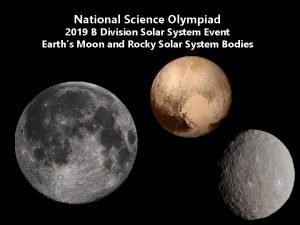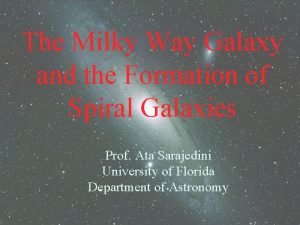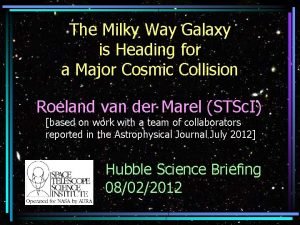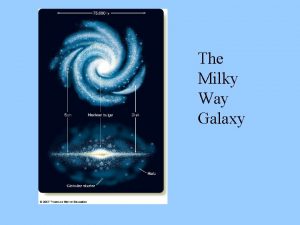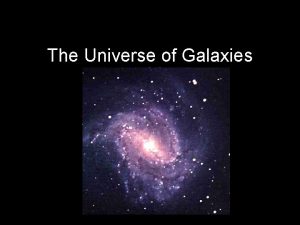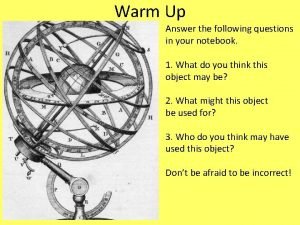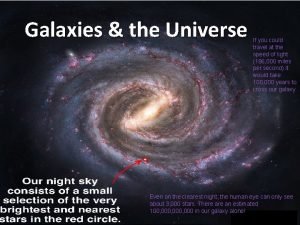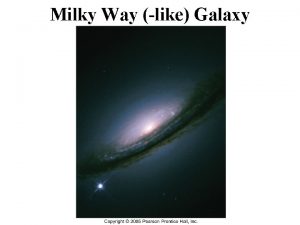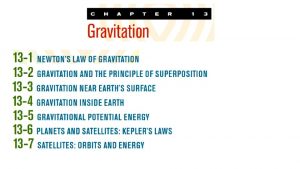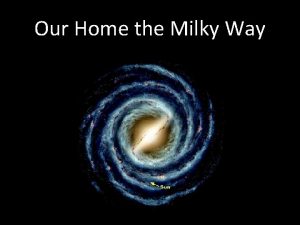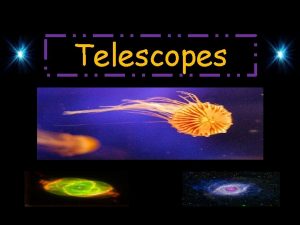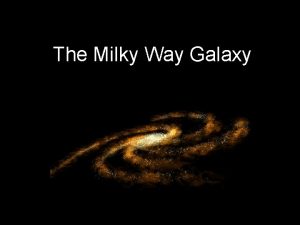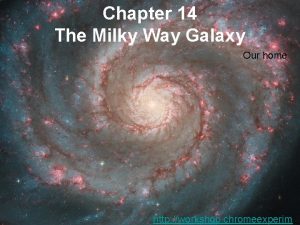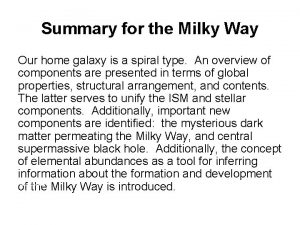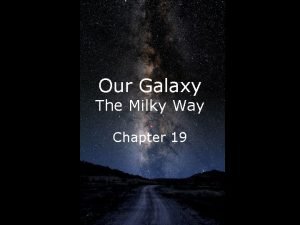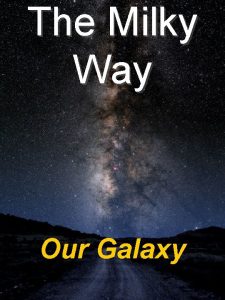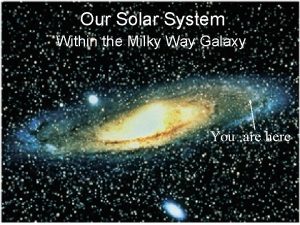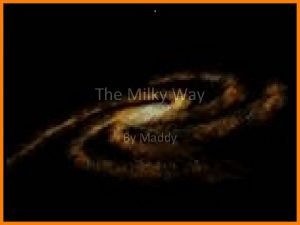The Milky Way Galaxy Our home in the













































- Slides: 45

The Milky Way Galaxy Our home in the Universe

Overview • Galaxies = groupings of matter within empty Universe – contain stars, dust, gas – formed in early Universe – many types of galaxies – groups of galaxies form clusters – groups of clusters form superclusters – some galaxies collide – some galaxies have very active (energetic) cores. Black hole at center?




Finding the center of the galaxy

Finding the center of the galaxy

Finding the center of the galaxy • The interstellar dust is concentrated in the plane of the galaxy, and therefore obscures our view of stars within the galactic plane. – Interstellar extinction • Like a motorist determines his position on a foggy day by looking for tall buildings that extend above the fog and are visible, astronomers determine the location of the galactic center from our view point by looking at stars (Globular Clusters) that are lie outside the galactic plane.

Finding the center of the galaxy • Astronomers use globular clusters (a class of star clusters associated with the galaxy but lie outside) in order to locate the galactic center. • However, one needs to know the distance to these clusters in order to find the center. • Astronomers use pulsating variable stars (Cepheid variables and RR Lyrae stars) that are found in globular clusters to find the distance to these clusters.


Finding the center of the galaxy • In early 90 s Henrietta Levitt discovered that the pulsation period of a Cepheid is directly related to it Luminosity. • Shortly after Harlow Shapley discovered an identical relation in RR Lyrae stars. • So, by measuring the pulsation period, we can know the luminosity, and from observations we can determine the apparent brightness of the star. Once luminosity and apparent brightness and luminosity are known, the distance can be determined.

Finding the center of the galaxy • Using the distance to globular clusters, astronomers have determined the galactic center to be approx. 8 pc away from us. • Before, these calculations (the first such attempts were made by Shapely in 1920) it was believed that the Sun (and thus the Earth) was at the center off the Galaxy. • Just as Copernicus & Galileo dislodged Earth from is long held special place at the center of the solar system, Shapley managed to show that Earth is nowhere near the galactic center.

Physical characteristics of the Milky Way • • • Disk shaped with central bulge Spherical halo of stars and globular clusters Spiral arm pattern About 1011 M REALLY BIG! – If Milky Way were size of Earth, solar system would be size of a cookie • Sun’s location: 2/3 from edge to center – 240 million year revolution period at Sun’s location

Physical characteristics of the Milky Way in infrared(IR) light: a) far IR from IRAS spacecraft. b) near IR from COBE observations. The light in b) come from stars in the plane of the galaxy


Things in the Milky Way • Star clusters – globular – open (Pleiades) – associations • Gas (form dark or emission nebulas) • Dust (form dark or reflection nebulas) • Stars – Population I - young stars – Population II - old stars

Star classification: Young vs. old • Population I – younger – bluer – located in spiral arms in disk • Population II – older – redder – located in globular clusters (halo) and galactic bulge

Star clusters • Globular – 105 to 106 stars, large, located in halo and nucleus (bulge) of galaxy, older stars (Pop II), no gas or dust • Open – few hundred stars, small, located in spiral arms, young (Pop I) stars, no gas or dust • Associations – very large, lie along spiral arms, very young blue stars, still contain gas and dust



Interstellar Matter: Gas and Dust • Dust – extremely sparse – very efficient at blocking visible light – blocks most of Milky Way from view in disk – “zone of avoidance” is region of sky along galactic disk where our view is blocked by dust – only infrared and radio can penetrate dust (see COBE photo of galaxy in infrared)

NGC 4565: How we would see the milky way if we could see it edge on. Gas & dust can be seen in the plane of the galaxy


Interstellar Matter: Gas • Gas – 90% hydrogen, 10% helium (by number) – can have molecules – cold gas: detected by absorption spectrum – emission nebula: emission spectrum, gas heated by nearby hot stars. Typically look red in pictures (hydrogen emission lines in the red part of spectrum). Called HII region.



Interstellar Matter: Dust • Dust – very small (nano- to micro- meter sizes) – consists of silicate core with icy surface – blocks light (makes distance objects dimmer and seem more distant), causes reddening of light from objects behind it by scattering blue light more than red light – reflection nebula: reflect starlight. Typically look blue in pictures (reflecting light from hot blue star)

Spiral Arms • How do we see them? – Mapped by looking for gas and dust concentrations using optical and radio information • 21 cm spin flip radio emission line • What are they? – Higher density regions - more stars per unit volume than other regions of Milky Way • Why are they? – Good question! Density waves?

21 centimeter (radio) line of hydrogen • Special radiation emitted by cold hydrogen allows us to map out cold hydrogen clouds (otherwise they are invisible) – detected at radio wavelengths of 21 cm – “spin-flip transition” • When the spin of the proton and the electron in a hydrogen atom are in the same direction they are in a higher energy state. • Then an electron can flip its spin and get to a lower energy state, and in the process emit radiation(photon) with a wavelength of 21 cm.

21 -cm radio emission from interstellar hydrogen gas.

The entire sky at 21 cm: We see that most of the 21 cm emission, and therefore, abundance of hydrogen gas in the galactic plane.

• Our galaxy has 4 major spiral arms. • Our Sun lies in one of the shorter spiral arms - the Orion arm

Why are there spiral arms? • Density waves - these denser regions are created when fast moving interstellar gas & dust moves into slow moving density waves or spiral arms. Then, this fast moving gas and dust gets compressed into a nebula. – This compression begins the process by which new stars are formed.

A density wave on a highway This process is similar to how a slow moving truck causes a traffic jam on a highway, creating a region of higher density of cars.

Density Wave model

Importance of spiral arms • Star formation definitely occurs in spiral arms – dust clouds seen going in on one side, stars going out on the other – spiral arms are home to youngest stars (including short-lived hot blue stars)


A spiral galaxy: M 83 Visible light We see evidence of star formations in the spiral arms in other spiral galaxies. 21 -cm radio wavelength.

The Galactic Center • In the very middle of our galaxy, something wild is happening – very powerful radio source (other radiations absorbed by bulge and disk) at very center only about 10 AU in size • towards constellation of Sagittarius – Million solar mass black hole? • Streams of antimatter also detected coming out in jets from center of galaxy - only black hole can do this

Formation of the Milky Way • Large cloud of swirling gas collapses to form disk and bulge (similar to Solar System) – localized collapses form early stars which enrich interstellar medium with heavy elements – Pop II stars formed early – Collapse complete, disk formed, spiral arms form, Pop I stars form – munching of smaller galaxies occurs • Eventually all gas and dust used up and star formation will cease

The Question of Dark Matter • The spiral arms of our Galaxy suggest that the disk rotates – The stars, dust and the gas is orbiting the galactic center. • The rotation rate of our galaxy has been measured. • These measurements can be used to find out the mass and the mass distribution of our galaxy.

The Question of Dark Matter • Recent calculations indicate that the mass of our Galaxy to exceed 1012 M. • However, observations from all forms of EM radiation (from radio waves to gamma rays) tells us that all the stars, dust and gas in the galaxy only account for 10% of the mass of the galaxy. • Then, what makes up the balance 90% of the mass of our galaxy? – Missing matter or Dark Matter problem

The Question of Dark Matter • This material, which seems not to emit any type of EM radiation (not even 21 cm radio waves), but which is by far the predominant constituent of our Galaxy is called Dark Matter. • The only way we “know” of its presence is due to the gravitational effects this matter exerts, and the corresponding effect on the rotation of our Galaxy.

The Question of Dark Matter • The nature of this mysterious dark matter has been and still is one of the leading research problems in Astrophysics. Current proposals are: – MACHOs: massive compact halo objects. Less than 1 M , dim objects like brown dwarfs, white dwarfs, or black holes. – Non zero Neutrino masses: Latest research in elementary particle physics sees signs that the elementary particle, the neutrino may have a small but a non zero mass as contrary to the predictions of the Standard model.

The Question of Dark Matter – Non zero Neutrino masses: Latest research in elementary particle physics sees signs that the elementary particle - the neutrino may have a small but a non zero mass. This is contrary to the predictions of the Standard model of particle physics. – WIMPs: Weakly interacting massive particles. This is a new class of subatomic particles predicted by a new theory (not yet confirmed by experiment). These particles have a mass but does not emit or absorb any kind of EM radiation.
 Spiral elliptical and irregular
Spiral elliptical and irregular Critical density
Critical density Science olympiad solar system
Science olympiad solar system Closest galaxy to milky way
Closest galaxy to milky way Milky way galaxy sketch
Milky way galaxy sketch Our location in the milky way
Our location in the milky way Our home galaxy
Our home galaxy Our home galaxy
Our home galaxy Milky way description
Milky way description The milky way
The milky way Where is the solar system located in the milky way
Where is the solar system located in the milky way Myfonterra
Myfonterra Democritus milky way
Democritus milky way Dung beetle milky way
Dung beetle milky way Jupiler
Jupiler Pr��ce v cestovn�� kancel����i praha
Pr��ce v cestovn�� kancel����i praha Nemertea
Nemertea Milky appearance of plasma
Milky appearance of plasma 3 chemical properties of oxygen
3 chemical properties of oxygen Come home come home jesus is calling
Come home come home jesus is calling She said that, home economics stands for the ideal home.
She said that, home economics stands for the ideal home. Perbedaan home care dan home visit
Perbedaan home care dan home visit Oak springs rv park
Oak springs rv park Home sweet home survive
Home sweet home survive New mobile home sales oak springs mobile home community
New mobile home sales oak springs mobile home community What did you say
What did you say Unit 1 home sweet home
Unit 1 home sweet home André fougeron
André fougeron Home care adalah
Home care adalah “the world is our home” is an example of
“the world is our home” is an example of The earth is my home i promise to keep it
The earth is my home i promise to keep it Slow way home
Slow way home Slow way home
Slow way home Slow way home
Slow way home Slow machines lesson 2
Slow machines lesson 2 Our awareness of ourselves and our environment is called
Our awareness of ourselves and our environment is called Our awareness of ourselves and our environment
Our awareness of ourselves and our environment Longing for peace our world is troubled
Longing for peace our world is troubled Our life is what our thoughts make it
Our life is what our thoughts make it Our awareness of ourselves and our environment is called
Our awareness of ourselves and our environment is called Our life is what our thoughts make it
Our life is what our thoughts make it God our father christ our brother
God our father christ our brother Money madness written by
Money madness written by Thinking language and intelligence
Thinking language and intelligence We bow our hearts
We bow our hearts Our future is in our hands quotes
Our future is in our hands quotes


